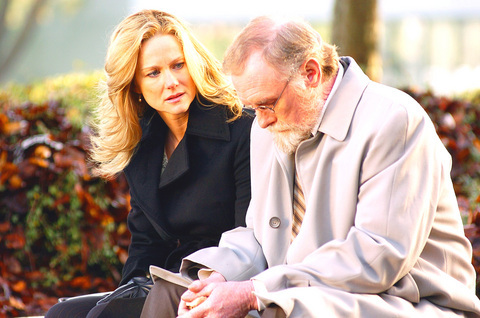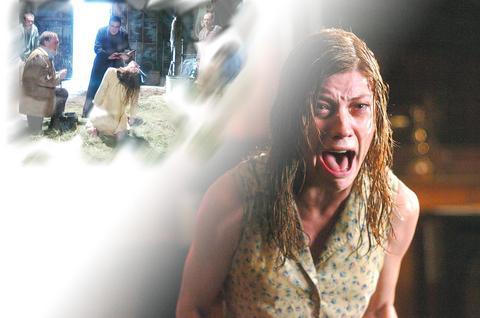The Exorcism of Emily Rose, directed by Scott Derrickson from a script he wrote with Paul Harris Boardman, is a horror movie wrapped in a courtroom drama. A priest (Tom Wilkinson) is accused of negligent homicide because a young woman in his care has died after a failed exorcism. For the defense, we have Laura Linney, whose character, Erin Bruner, is an ambitious lawyer with somewhat better taste in liquor than in courtroom attire. For the prosecution, with gray at his temples and a neat little mustache riding his lip, there is Campbell Scott, whose character's steely patience eventually wears thin. "Your honor, I object," he exclaims, as every good courtroom-drama lawyer must. On what grounds? "Well, silliness, for one."
Sustained. But objecting to silliness in a horror movie is a bit unfair. The whole point of the genre -- the fun as well as the terror -- lies in the suspension of disbelief. The Exorcism of Emily Rose, however, goes a bit further. Announcing from the start that it is "based on a true story" (words guaranteed to scare most movie critics), it tries to nudge its audience toward a real-world condition of belief in the supernatural doings it depicts.
Though Derrickson deploys the usual techniques of scary-movie making with a reasonable degree of competence, he does so for unusually high stakes. This is not meant to be just another spooky story, but rather a matter of (eternal) life and death, a religious argument decked out with dark and stormy nights, yowling cats and low-rent creep show effects.

The tale is fairly simple, and curiously lacking in suspense. We know from the start that Emily (Jennifer Carpenter), a devout 19-year-old who grew up in a rattling clapboard house in the middle of an empty field, is dead. The details of her last months are filled in by Father Moore (Wilkinson), who is either haunted by what he has seen or else suffering from chronic gas pain.
Wilkinson, usually a strong and subtle actor, here gives us no clue as to Father Moore's state of mind. Carpenter's Emily is a blank slate scribbled upon by diabolical forces. Though she flails and howls gamely, she is no Linda Blair. Her head does not spin, nor does she vomit green bile. Still, she does perform some extreme yoga poses, eats a handful of bugs and caterwauls in several languages, helpfully subtitled.
This leaves Linney to bear the burden of the drama, which she does with characteristic grace. Erin pronounces herself an agnostic, but stopped clocks and other ominous portents push her from skepticism toward acceptance of her client's view. Father Moore insists that Emily was in the grip of the Devil's minions, even as the prosecution presents an array of expert witnesses arguing that she suffered from a medical rather than a spiritual condition. Erin, in turn, unearths an anthropologist (Shohreh Aghdashloo) who studies demonic possession and is studiously noncommittal as to whether it really exists.

The movie pretends to take the same tolerant, anything's-possible position. While not especially good -- judged strictly on its cinematic merits, it ranges from OK to god-awful -- it is still a fascinating cultural document in the age of intelligent design. Its point of view suggests an improbable alliance of postmodern relativism and absolute religious faith against the supposed tyranny of scientific empiricism, which is depicted as narrow and dogmatic.
The sincerity of a believer -- Father Moore, in this case -- is conflated with the plausibility of his beliefs. The doctors, meanwhile, seem so sure of themselves. But of course, the movie says, no one can ever be completely sure, and thus superstition becomes a matter of reasonable doubt. Meanwhile the clocks stop, the wind howls, and we are encouraged to believe -- or at least not to disbelieve -- our own eyes. Father Moore knows what he saw. So do I: propaganda disguised as entertainment.

This year will go down in the history books. Taiwan faces enormous turmoil and uncertainty in the coming months. Which political parties are in a good position to handle big changes? All of the main parties are beset with challenges. Taking stock, this column examined the Taiwan People’s Party (TPP) (“Huang Kuo-chang’s choking the life out of the TPP,” May 28, page 12), the Democratic Progressive Party (DPP) (“Challenges amid choppy waters for the DPP,” June 14, page 12) and the Chinese Nationalist Party (KMT) (“KMT struggles to seize opportunities as ‘interesting times’ loom,” June 20, page 11). Times like these can

June 23 to June 29 After capturing the walled city of Hsinchu on June 22, 1895, the Japanese hoped to quickly push south and seize control of Taiwan’s entire west coast — but their advance was stalled for more than a month. Not only did local Hakka fighters continue to cause them headaches, resistance forces even attempted to retake the city three times. “We had planned to occupy Anping (Tainan) and Takao (Kaohsiung) as soon as possible, but ever since we took Hsinchu, nearby bandits proclaiming to be ‘righteous people’ (義民) have been destroying train tracks and electrical cables, and gathering in villages

Dr. Y. Tony Yang, Associate Dean of Health Policy and Population Science at George Washington University, argued last week in a piece for the Taipei Times about former president Ma Ying-jeou (馬英九) leading a student delegation to the People’s Republic of China (PRC) that, “The real question is not whether Ma’s visit helps or hurts Taiwan — it is why Taiwan lacks a sophisticated, multi-track approach to one of the most complex geopolitical relationships in the world” (“Ma’s Visit, DPP’s Blind Spot,” June 18, page 8). Yang contends that the Democratic Progressive Party (DPP) has a blind spot: “By treating any

Swooping low over the banks of a Nile River tributary, an aid flight run by retired American military officers released a stream of food-stuffed sacks over a town emptied by fighting in South Sudan, a country wracked by conflict. Last week’s air drop was the latest in a controversial development — private contracting firms led by former US intelligence officers and military veterans delivering aid to some of the world’s deadliest conflict zones, in operations organized with governments that are combatants in the conflicts. The moves are roiling the global aid community, which warns of a more militarized, politicized and profit-seeking trend